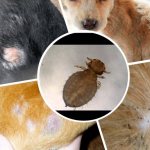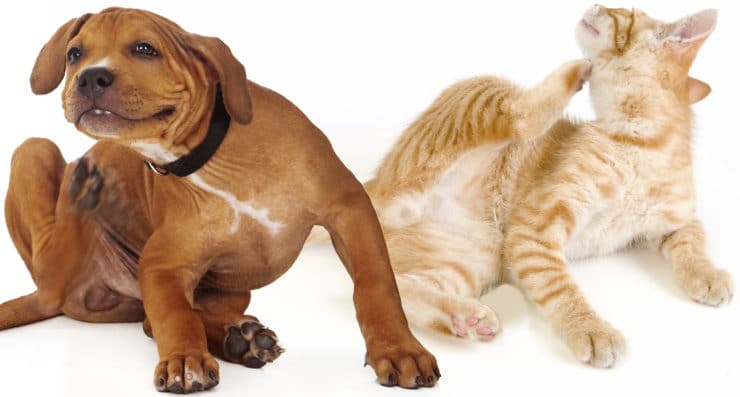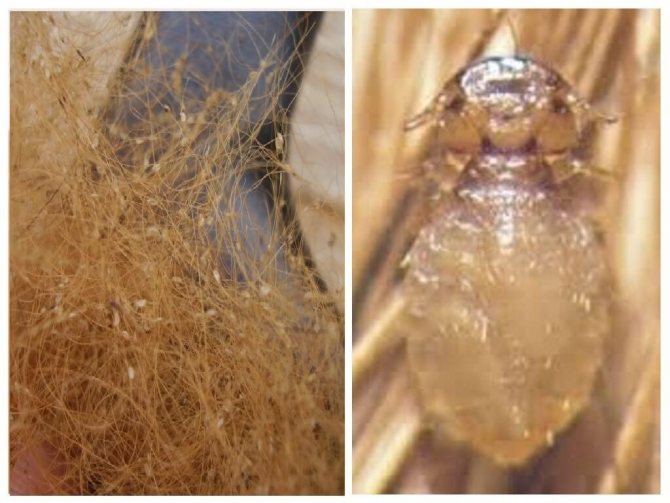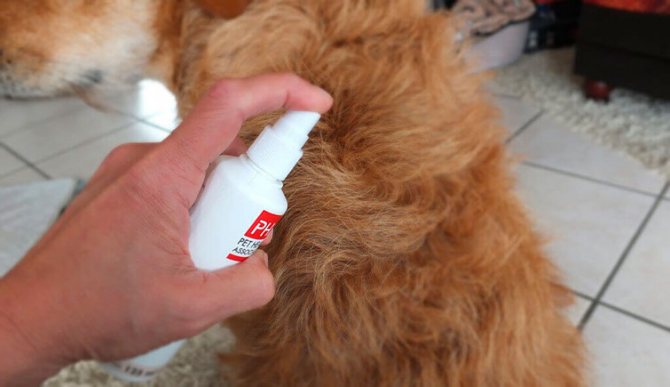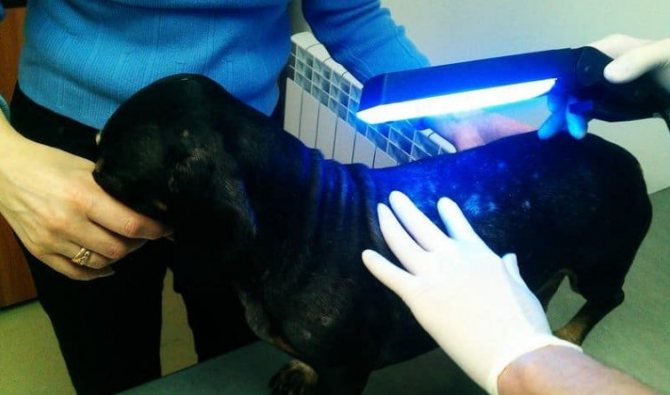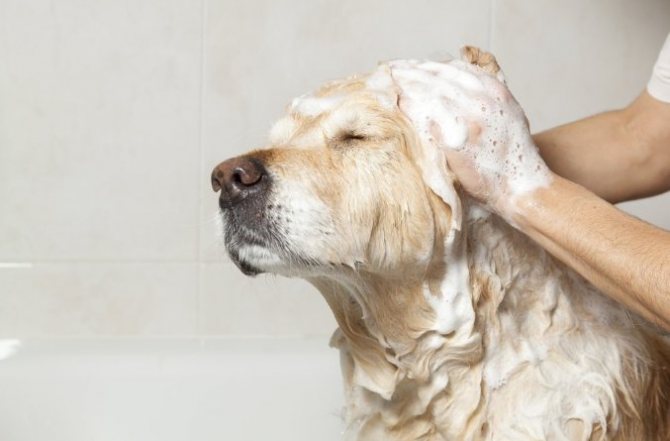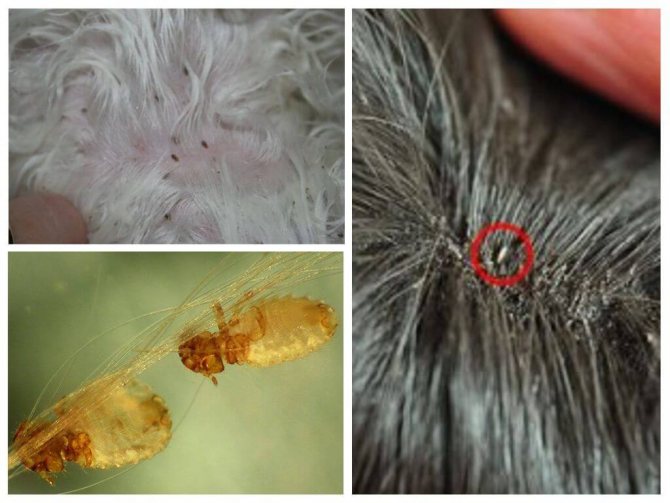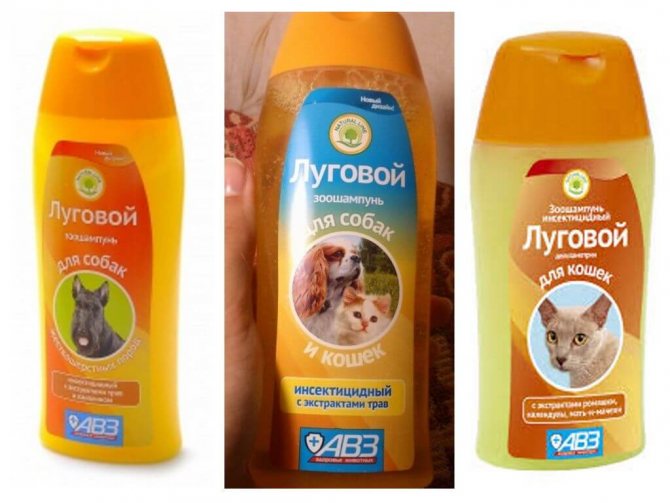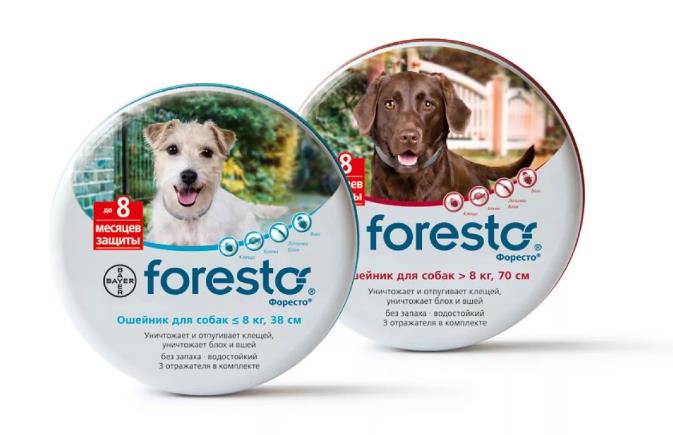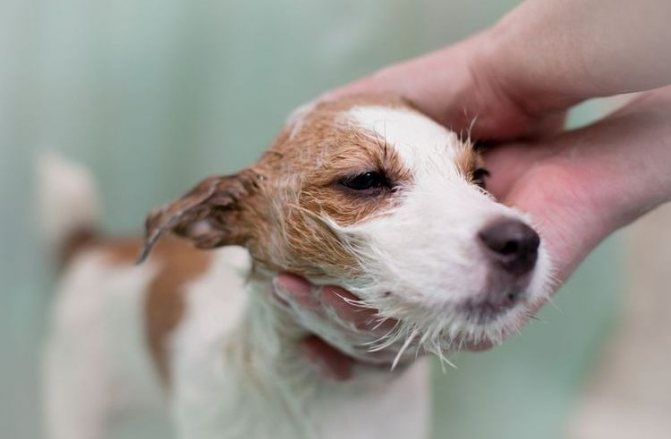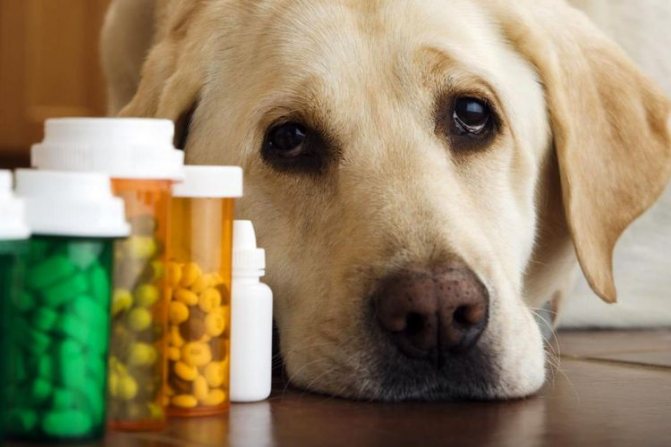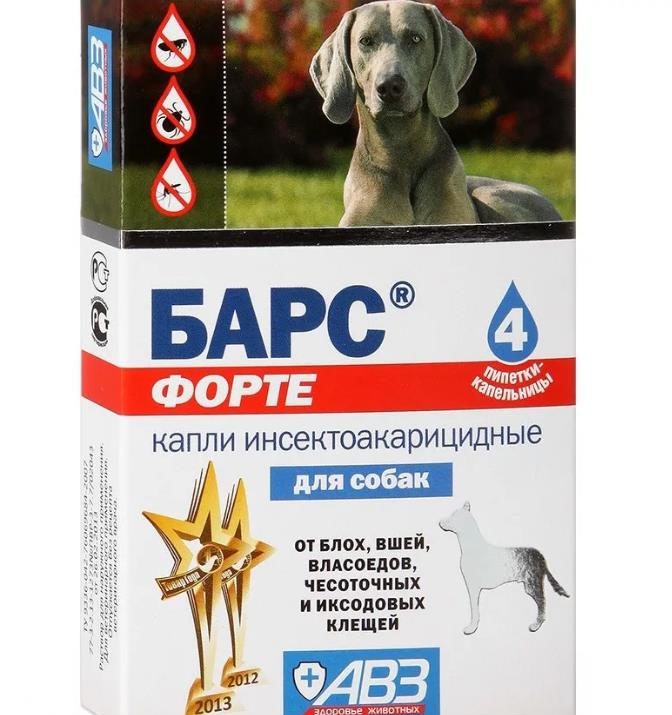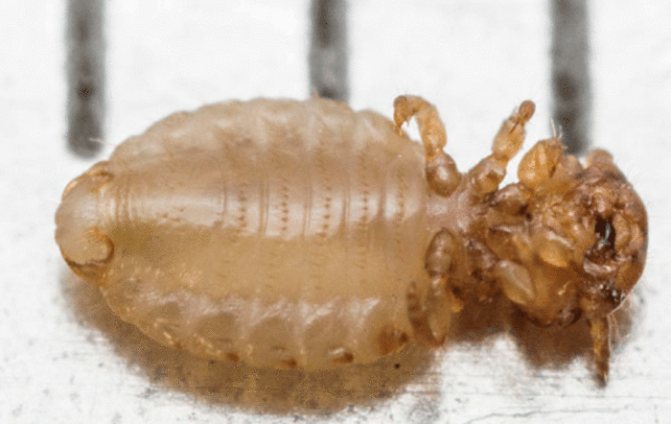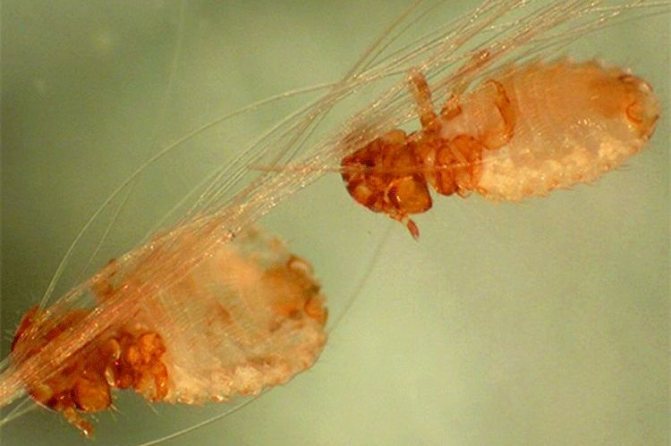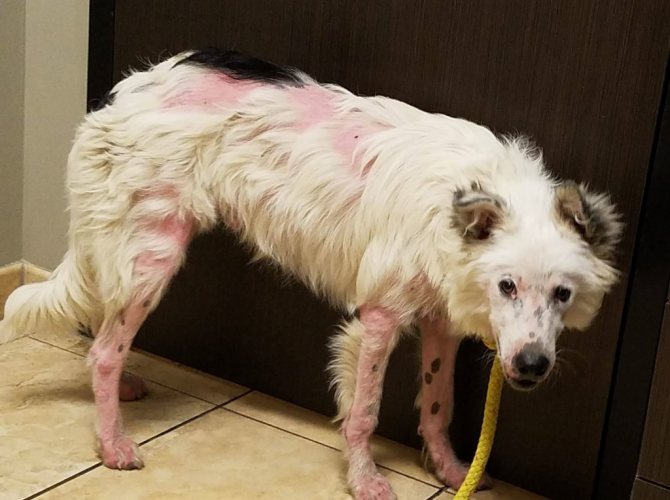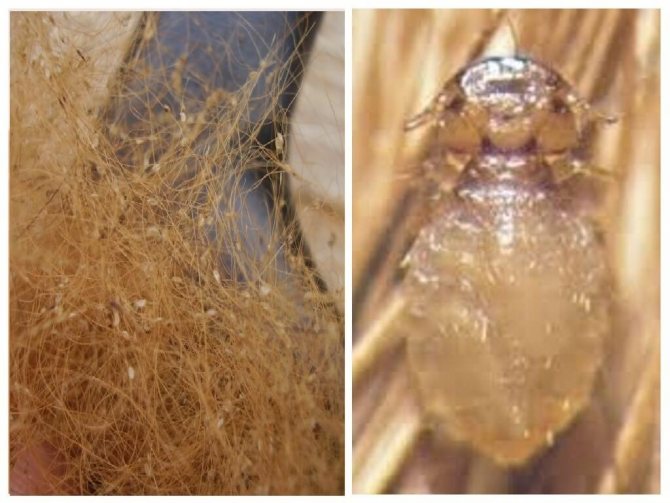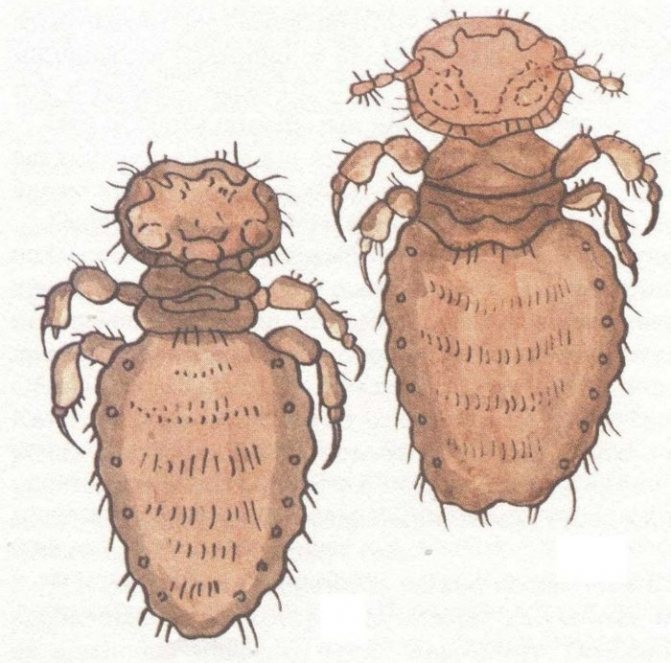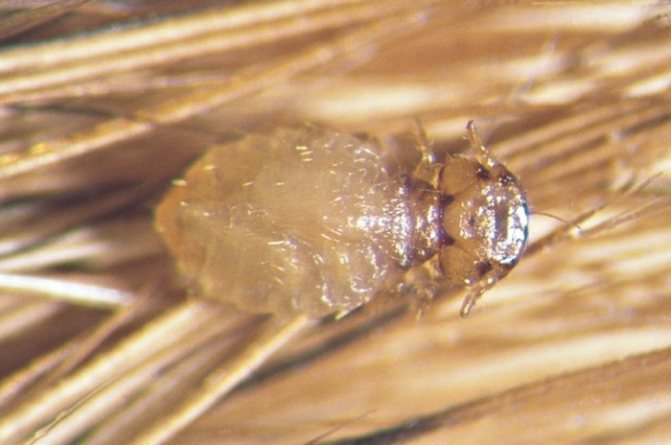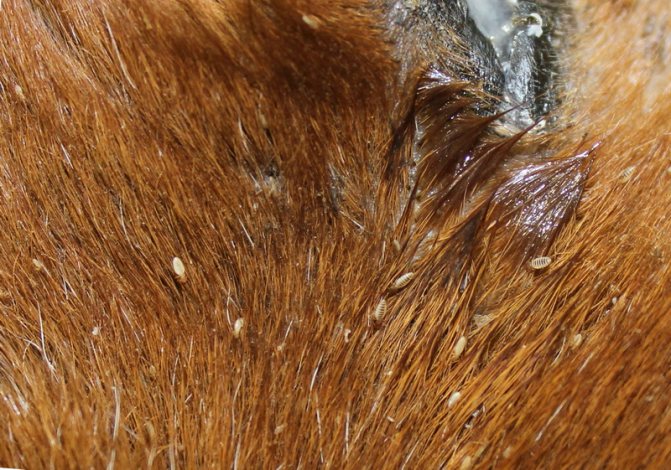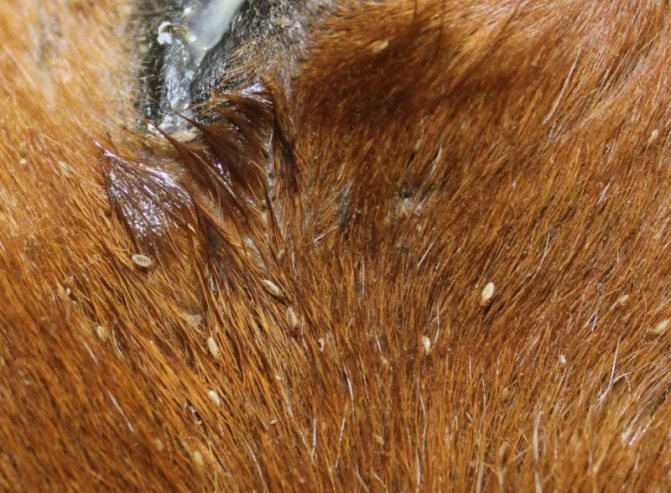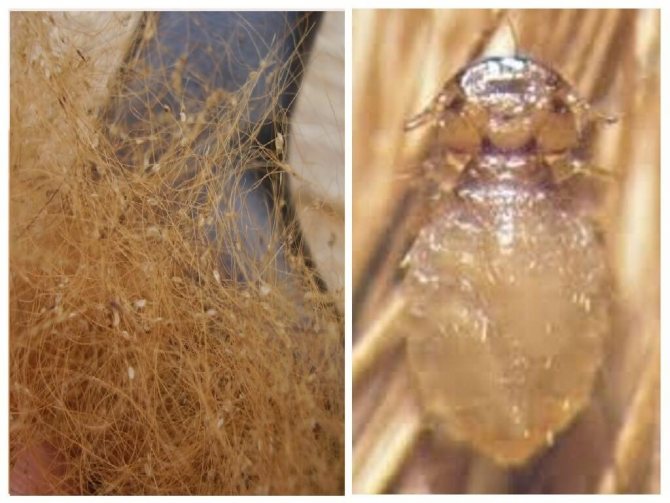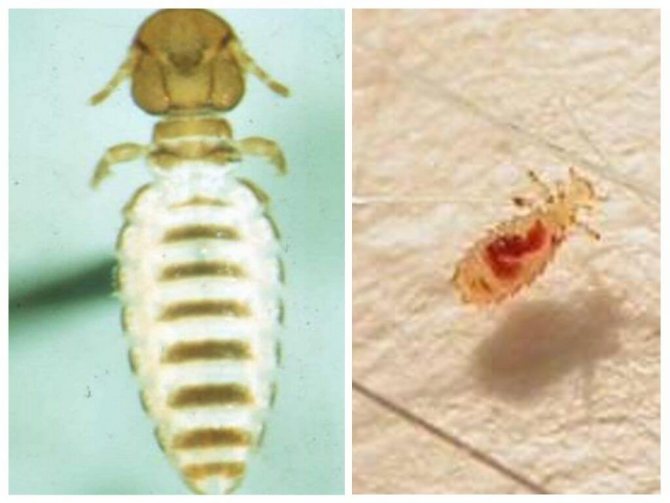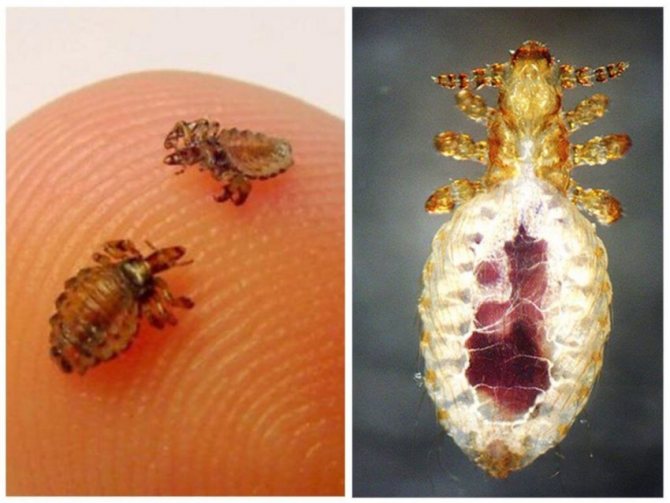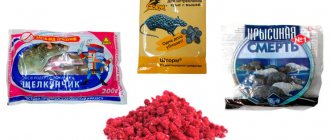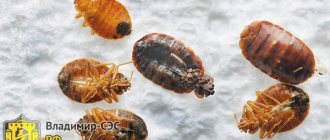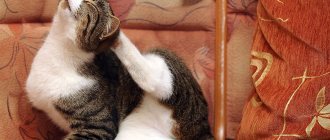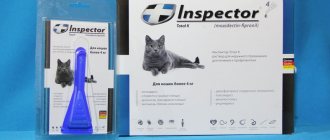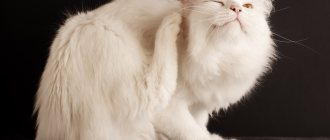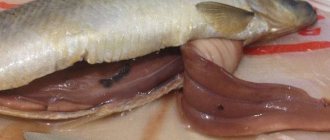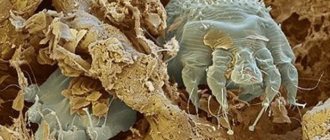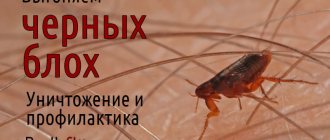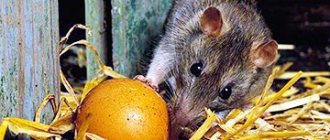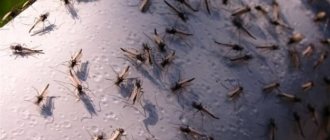The lice-eating mite, or the lice-eating mite, is an ectoparasite that lives on the skin and feeds on wool, skin particles, blood, lymph and secretions of the sebaceous glands. A small insect, barely visible to the eye, can create big problems for dogs. Infection with them is accompanied by itching, wounds, infections, baldness and recurrence of chronic diseases. Infection with them is called trichodectosis.
Usually, the owners worry about the safety of pets in the summer. During the period of activity of fleas and ticks, but the louse is especially active in winter, low temperatures do not prevent it from actively reproducing and infecting new animals.
Outwardly, this insect is very similar to a louse, they are often confused. A small brown body, visible only in large clusters, helps it mask for a long time. The macro photographs show that the tick differs from the louse in the structure of the mouth, which works according to the gnawing principle.
How to get rid of parasites
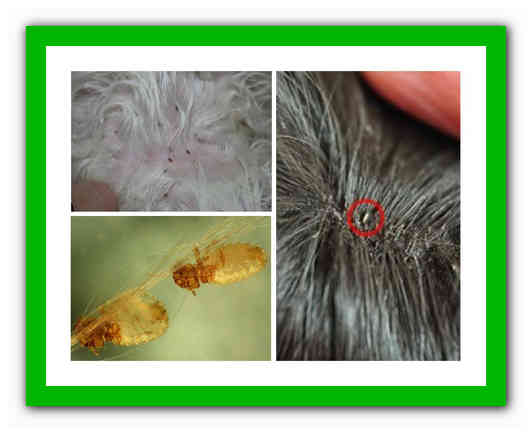
Many owners are puzzled by the question of how to get rid of lice in dogs. After all, trichodectosis is a very dangerous disease. To prevent the development of infection, it is necessary to carry out immediate treatment of lice in dogs.
Only an effective remedy can correctly remove the lice from the dog. The same medications are used to get rid of fleas in dogs. Today manufacturers offer a lot of antiparasitic products that come in the form of sprays, drops, shampoos and even collars. All these drugs for lice make it possible to treat yourself at home on your own. They can be purchased at any veterinary clinic or specialized store in Moscow.
Pediculicidal shampoos - this is what you can even treat lice in puppies. These detergents also provide effective disposal of lice, ticks and fleas. They have a moisturizing effect, due to which the itching of the pet is reduced. The dog's coat acquires a healthy appearance, brushes well, becomes smoother and more silky. Most of these detergents have a pleasant aroma and do not cause allergic reactions. Shampoos are recommended for different breeds and ages:
- The shampoo is applied to the dog's wet coat. Especially carefully you need to process contaminated and matted places, using a larger amount of funds.
- It is inadmissible to get the cleaning solution into the eyes of the animal.
- The solution is rubbed in with massage movements and to achieve the effect, leave on the dog's body for the time specified in the description (usually at least 5 minutes).
- After that, the pet's hair is thoroughly washed with water, dried with a hair dryer, and the dead insects are combed out.
Zoo shampoos are in great demand among consumers: Lugovoy, Fitoelita, Demos-Lux.


Shampoos do not have a long period of protection, therefore, when using them, re-treatment is indispensable.
Drops from the louse in their composition contain insecticidal components, due to which they have a detrimental effect on parasites. This method of struggle is one of the most effective. In addition, the drops have a long period of protection: the product is able not only to remove the lice already present in the dog's fur, but also prevents the possibility of re-infection for a long time (up to 6-8 months). The medicine must be dripped into places inaccessible for licking (on the withers or spine). Many owners prefer drops of the following brands: Dana, Bars, Irbis, Advantage.
Means for lice in the form of sprays have a composition similar to drops. Their distinctive feature is the concentration of the insecticide and the method of application.To rid the pet of parasites, almost all of its hair is sprayed with an aerosol.
Particular attention is paid to the back, hips, abdomen, neck and head. The most popular sprays are Frontline, Defendog or Decor 1
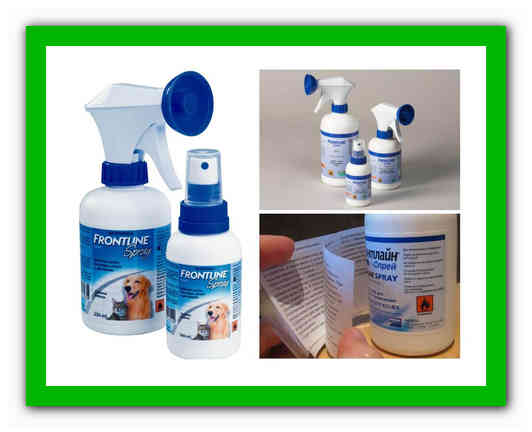

You can also be treated for lice with the help of injections, you just need to bring the dog to the veterinary clinic. A collar will help save your pet from the invasion of parasites. However, this method of struggle has many contraindications, so consultation with a veterinarian is necessary. There are also insecticidal suspensions that need to be diluted to treat the dog.
Whichever means of struggle you prefer, its use should be made in accordance with the instructions, weight and age of the dog.
Folk remedies
Treatment with folk remedies for dogs can give a positive result in the fight against lice. A man has long discovered the healing properties of a string, wormwood and chamomile. It is especially useful to use decoctions of these herbs for small puppies. However, their use is effective only at the initial stage of pet parasite infestation.
Treatment
Despite the serious consequences of a hair mite infection in dogs, treatment is quick and painless. Provided that more severe consequences such as eczema or dermatitis are avoided.
Treatment is to get rid of the parasite. The wool is treated with insecticidal agents. There are a huge number of antiparasitic drugs, the choice always remains with the owner. The main thing is to follow the instructions of the drug.
Attention! In case of complications, allergic reactions, advanced cases of infestation with a hair mite, an appeal to a veterinarian is a prerequisite. Extensive infestations can have serious consequences that are not noticeable to the dog owner.
In the initial stage of infection, you can use an antiparasitic drug twice with an interval of 7 to 10 days. After the first application, the larvae and sexually mature parasites die, after the second the larvae hatched from the eggs. Treatment with shampoos is suitable for young animals, practically has no contraindications.
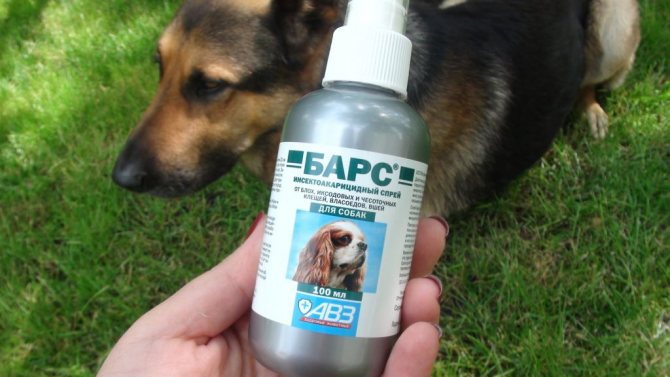

One of the means of struggle
Trihodectosis is treated with various drops against chewing lice and lice. The drops contain an insecticidal preparation that kills both lice and eggs. The main condition for use is the inadmissibility of the dog to lick off the drops, as this is fraught with severe poisoning or allergies. The drug should be applied between the ears, then on the withers and back. The main advantage of this remedy is the subsequent protection for 3 - 5 weeks from the infestation by the louse.
There are antiparasitic sprays commercially available, the composition of which is almost identical to the drops. It is necessary to treat the dog with aerosols carefully, avoiding contact with mucous surfaces, in the ears. After processing, carefully monitor for some time so that the dog does not lick the preparation from the coat.
In combination with drugs, the treatment of hair mites in dogs by folk methods is permissible. You can wash the animal with a decoction of wormwood, chamomile or string. The scent of these herbs will repel blood-sucking insects.
In case of complications caused by the louse, the veterinarian may prescribe additional treatment with antihistamines, antibiotics, anti-inflammatory drugs. Everything will depend on the results of the examination, analyzes.
After treatment, all objects with which the animal comes into contact are subject to mandatory disinfection, and the house - general cleaning. The harness and the bed are processed with the same means as the dog.
Prevention of lice infestation
Prevention of lice eaters involves regular treatment of the dog from blood-sucking parasites. Depending on the owner's preference, drops, sprays, collars and shampoos can be used to prevent parasites in the dog.
Shampoos for skin parasites do not have a prolonged action. Simply put, they allow you to get rid of the lice here and now, but after 3-4 days the dog can become infected again. Reinfection does not require contact with the host of the parasite, as microscopic eggs can remain adhered to the dog's fur.
Important! The spray helps protect the dog while walking and in direct contact with parasites. Usually, the spray has a pungent, repulsive odor that disguises the dog from the sensory organs of blood-sucking insects.
Drops are considered the most reliable and convenient means of prevention. Usually, the drops protect against fleas, ticks and lice. Some drugs also protect the dog from mosquitoes, which is important if you live in an area where heartworm disease is common. If you carefully read the instructions of the drops, you will find that they protect against fleas 2 times longer than against ticks. Since lice are arachnids and belong to the family of ticks, the dog needs to be treated more often to prevent them.
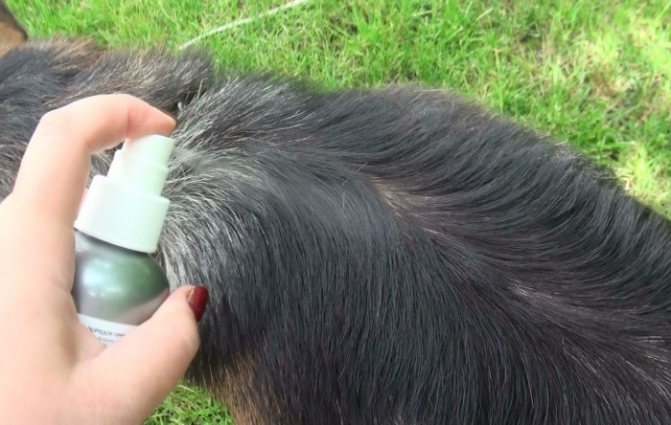

Practice shows that the most effective drugs protect the dog for no longer than one month. For reliable prevention, the pet needs to be treated regularly all year round. The frequency of treatments can be reduced in winter, especially in frosty weather.
Prophylactic collars are invented to fight fleas and pasture ticks, they do not help much against lice and subcutaneous ticks. Insecticides, which are gradually released from the collar, are absorbed into the skin and spread over its entire surface.
The use of a collar allows you to prolong the action of drops, reliably protect the dog from fleas and partly from ticks. Data on the preventive effect on lice are not provided, since these parasites are widespread only in some regions and global studies have not been conducted.
Prevention measures
The main preventive measures include sprays, drops, shampoos, collars from blood-sucking parasites. You can use them at your own discretion, whoever is convenient.
It is also necessary to avoid contact with sick individuals, stray animals. They are the main carriers of fleas and lice. If communication with a potential distributor could not be avoided, and the pet was not treated with antiparasitic agents, sanitization should be carried out immediately, without waiting for symptoms.
Timely cleaning of premises, change of beds, disinfection of equipment are indispensable helpers in the fight against lice eaters.
Possible routes of infection
Basically, lice get on a healthy animal after contact with an infected individual. This can happen while playing, fighting or mating. The danger of lice is largely due to the fact that such contacts are almost impossible to avoid, because even a home and well-groomed pet can be a carrier of parasites.
In addition, dogs can become infected with lice through household items. The owner can also act as a carrier - nits can linger on his shoes or clothes. It can also carry lice eggs on its hands by simply stroking an infected dog.
Puppies can become infected with lice while they are still feeding.
Lice are especially common during the cold season. Lice catalysts can be factors such as non-observance of basic hygiene rules, poor balanced nutrition, as well as the old age of the dog.
Where do dogs and cats get lice?
There can be many reasons for the appearance of a louse in a pet, and it is impossible to establish exactly what exactly led to the infection of the animal. The most common are the following ways of infecting cats and dogs with these representatives of chewing lice:
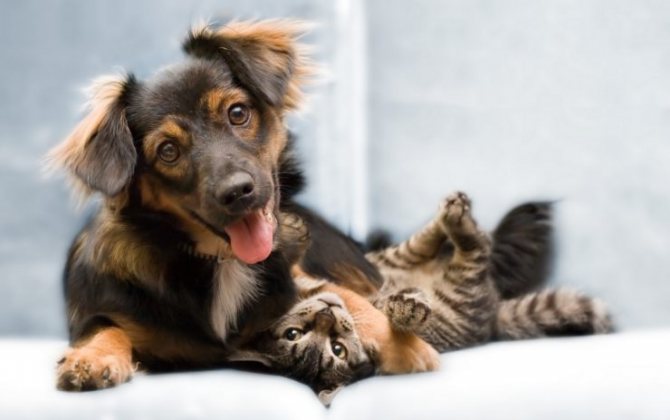

- Contact with infected animals while walking. In this case, the cat can pick up parasites from the dog and vice versa.
- Mating with an infected partner.
- Use of contagious animal hygiene items (muzzle, leash, brush, bedding) for pet care.
- Grooming, combing out with untreated tools that were used to shear, combed out the infected animal.
- Through the owner's street shoes.
- Hunting for mice and rats that can carry these pests.
- Infection of newborn kittens and puppies from the mother.
There are a number of factors that increase the risk of infection of a four-legged friend with these ectoparasites:
- poor conditions for keeping the pet (rare washing of the animal and untimely cleaning of its things);
- high air humidity in the room where the cat or dog is kept;
- improper nutrition;
- weakening of immunity due to unbalanced nutrition, improper maintenance or previous severe diseases.
Vlaseoids in dogs what they look like and why are they dangerous?
Trichodectes canis (trichodectosis, louse) is one of the varieties of microscopic mites, more precisely, lice, which are common all over the world, parasitizing both domestic and wild dogs. In addition to the direct harm that the parasite causes to the pet, it is the carrier of the most common - cucumber tapeworm.
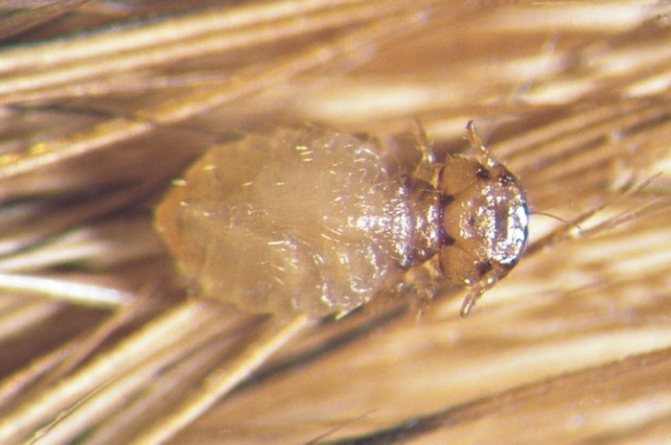

Note! It usually takes 3 to 5 weeks from the moment the egg hatches to the natural death of the parasite. Only females actively parasitize on dogs, so the life cycle of males has not yet been studied
For the owner, the louse is not dangerous, but this parasite brings great discomfort to the pet, especially with extensive damage. What do lice look like? The body of the parasite is small and flat. Males are smaller than females, in addition, individuals of different sexes differ physiologically.
The female louse lays eggs and carefully attaches them to the individual hairs of the dog. Eggs usually mature for 5–8 days. After opening the egg shell, the larva molts and becomes a nymph. To begin to reproduce, the parasite must go through two more molts, but even at the first stage of development, the louse is physically complex, like an adult.
Basic information
As a rule, ectoparasites thrive especially well in situations where animals are kept in crowded and crowded conditions. In addition (and to our great regret), lice and fleas often appear in animals that often participate in exhibitions. The reason for this is the unsatisfactory veterinary control and the lack of disinfestation of the exhibition premises after receiving the next batch of animals. From pet to pet (most often), parasites are transmitted by direct contact, but in the same fleas, infection occurs when the cat / dog is in a room where there are parasite larvae.
The life cycle of bloodsuckers of different species can differ significantly from each other. So, unlike fleas, lice experience their entire life cycle on an animal... Adult female insects lay eggs by sticking them tightly to hair shafts. In the literature, they are often referred to as "nits". Since they have a "camouflage" color, only the owner with certain experience can see the signs of infection at first glance. Nymphs emerge from the eggs, intermediate stage. They look like adult lice, reduced several times. They shed several times and become adults. The entire development process from egg to adult takes 2-4 weeks. Life cycle lice proceeds in approximately the same way.
How to get rid of lice at home with folk remedies
Some owners, choosing ways to get rid of lice at home, prefer folk remedies. The most common of these are the following recipes.
- Bathing with tar soap, followed by combing out the parasites. Since soap does not work on eggs, the treatment must be repeated after 8-10 days.
- You can add a few drops of tea tree, cedarwood, eucalyptus, mint or citrus essential oil to your bathing water. Their smells scare away insects, but do not kill them. Therefore, combing out parasites is a must.
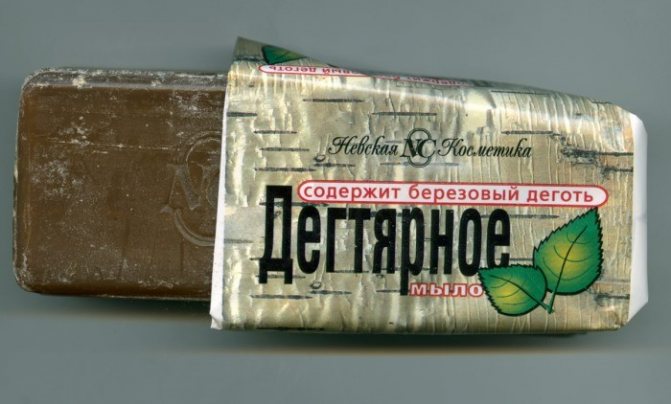

- Processing with tincture of wormwood, prepared from 40 g of fresh or 20 g of dry grass and 1 liter of boiling water. After application, the solution does not require rinsing. Processing is carried out 1 time in 3 days until the complete destruction of the lice.
- Instead of wormwood, you can use decoctions of tansy, rosemary, lavender and geranium, which are safe for puppies and pregnant females.
Important! Some sources present recipes based on garlic. But due to their high toxicity for dogs and a persistent unpleasant odor, veterinarians do not recommend using them for pets.
Benefits of folk methods
Despite the fact that the use of traditional methods of getting rid of ectoparasites requires a long time and regular frequent treatments, they have certain advantages over the use of synthetic insecticides.
These include:
- the possibility of using for young individuals, pregnant and lactating females;
- no contraindications in the form of scratching, wounds or on the dog's body;
- financial availability.
But it should be understood that combing out after treatment with folk remedies is a mandatory procedure, since it increases the effectiveness of treatment several times.
Can a person get infected from a sick dog
In theory, yes. The insect can be on the human body, even in the hairy part of it. But the life cycle cannot begin - it is too cold in human hair. The body temperature is low for the reproduction of lice, which saves dog breeders from parasites.
But the danger can be in helminths and tapeworm eggs, which can be transmitted by itching. Therefore, if a pet is infected with a louse, pet owners should be careful. If you notice insects on yourself, it is enough to wash with shampoo and comb with a fine comb.
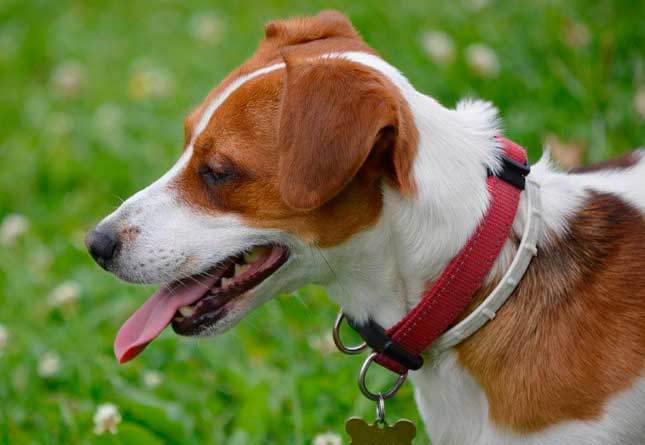

On a walk with a flea collar
General information
Demodectic mange, also known as "hair mite", is one of the most common skin diseases in dogs. There are predisposed breeds, which include:
- German shepherds.
- Dobermans, Rottweilers, Boxers.
- Bulldogs of all varieties (but the most predisposed are "French"), as well as Great Danes and Dachshunds.
The owners of these animals need to be especially careful in order to immediately notice the first symptoms of an unpleasant pathology.
Please note - today, most scientists believe that bulldogs and boxers are lifelong carriers of ticks, so you should limit the communication of your pets with animals of these breeds. The likelihood of developing the disease is greatest in the spring-summer period, since at this time the development cycle of the parasite is reduced to only two weeks.
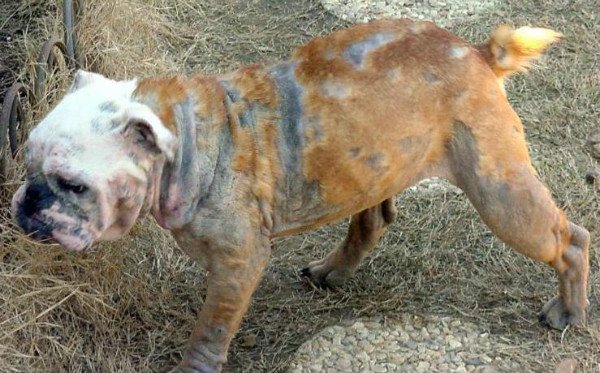

It has been proven that the development of the disease is facilitated by improper feeding (the lack of vitamins A and E is especially destructive), as well as prolonged use of antibiotics and / or non-steroidal anti-inflammatory drugs.
What are the symptoms? In the mildest cases, hairless areas appear on the dog's body, the skin on which flakes. As a rule, this form of the disease is not dangerous, self-healing occurs (if the animal's immunity is not weakened). But the generalized variety is more common. At the same time, hairless areas cover a large area of the dog's body, the skin in these places thickens, it can become very red and coarse, and very strong peeling is observed.
If you look closely, you can easily notice the movement of exfoliated skin scales (due to the movement of parasites in the subcutaneous layer). This is a very dangerous form of the disease, as in this case mites "lodge" not only in the skin, but also in the internal organs.In addition, there is a high likelihood of developing secondary skin infections, ulcers, erosions, and other defects. In advanced cases, the dog becomes almost bald, the skin peels off and even falls off in rags.
Symptoms
Once on the skin, the lice quickly begin to "master" - they actively lay eggs and leave the products of their vital activity on the wool. Signs of the presence of parasites are easy to identify:
- the dog is constantly itching, whining, showing anxiety.
- characteristic bald patches appear in the neck, thighs, tail and ears, and the skin in problem areas becomes inflamed and reddened.
- scratches turn into wounds, and those, in turn, turn into scabs and poorly healing crusts.
- the coat becomes dull, untidy, rolls into tangles.
- the animal suffers from insomnia, loses its appetite and is constantly thirsty.
Untimely started treatment or its absence can lead to various complications: dermatitis, allergies, fungal infections, etc. The most dangerous thing that awaits an animal with an unfavorable course of the disease is the development of leptospirosis. In such cases, there is a high probability of death, especially when it comes to puppies or young dogs.
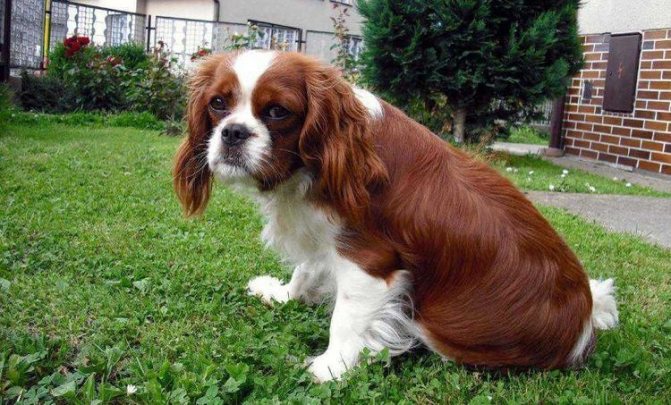

Prevention of infection
In order to protect your pet from trouble, you need to take precautions:
- follow all hygiene rules;
- conduct a constant examination of the dog's skin and coat;
- regularly treat the place of residence of the animal with means for prevention;
- if possible, use all available means that repel insects (collars, wormwood twigs, special sprays and combs); such products can be sprayed on the fur of the animal, and also placed in a booth or box where the dog sleeps; you can rub the animal's hair with a dry mixture of wormwood leaves;
- make sure that the dog does not come into contact with or suspicious pets.
In the end, we note that in order for the animal to grow and develop normally, it needs proper care, attentive attitude and regular examination by a veterinarian. We must not forget that by taking a dog into our house, we are responsible for it. In return for our care, we get a loyal and devoted friend, as well as a reliable and courageous guard and partner.
Prevention of ailment
The prevention of lice is:
- Pet hygiene - regular washing and brushing of the coat.
- Minimizing dog contact with stray animals.
- Timely treatment of a pet from parasites, using any of the means of protection - drops, collars or sprays.
None of the remedies give a 100% guarantee and will not protect the pet from all misfortunes. For more complete protection and peace of mind of the owner, the products can be combined using different active substances in different forms - for example, a collar and drops or a collar and spray.
What parasites look like
The presence of lice on the dog's body provokes a dangerous disease called trichodectosis. And before starting the fight against parasites, you need to know what they look like.
Vlasoed is a small insect parasitizing on the body of warm-blooded animals. Its flat, flattened body does not exceed 2 mm in length and most often has a grayish-transparent or pale yellow tint. Therefore, it is not always easy to find a pest. Outwardly, lice are very similar to lice. Their distinctive feature is the head. In wingless insects, it is quadrangular in shape and much larger than the chest. Below you can see what the dog's lice look like in the photo.
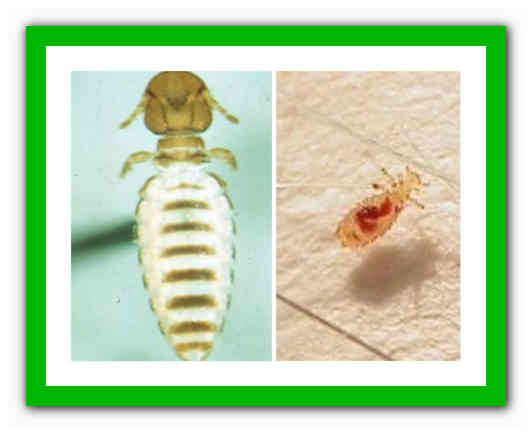

The pest feeds on particles of skin and wool, which is why it is popularly called kozheedom, puff lice or itch. He is also attracted by caked blood, which is formed as a result of exhausting scratching of the animal.
Reproduction in parasites is quite active: one female is capable of laying about 6-7 dozen eggs, which she firmly attaches to her hair with a sticky liquid. That is why it is not easy to wash off the lice eggs with water or comb them out. After 5-10 days, lice larvae appear from them, which molt at least three times before becoming sexually mature individuals. This process takes them about a month.
What is a parasite?
The tick is able to feed not only on the blood of an animal, but also on lymph and epidermal scales. Insects are active at certain times of the year. When the air temperature heats up to + 10 ° C, then favorable conditions for the parasites come. They begin to look for a host from whom they could receive regular food. This activity continues until mid-June.
The second wave begins around the end of summer. If the weather is warm for a long time, then the parasites will be active until October.
There are several types of lice:
- Ixodids are the largest representatives of this individual. They can be easily found in wool. Lead to serious blood diseases in a pet. This type of insect is dangerous for humans.
- Scabies are the most dangerous representatives. They cause the most unpleasant symptoms. It is almost impossible to detect them without the use of optical devices. However, the pet's skin turns red, and excruciating itching is constantly present.
- Subcutaneous - are taken under the epidermis and feed on blood there. It is impossible to detect such a parasite on your own. This variety does not even reach 1 mm.
Ways to deal with lice
When a dog has lice, treatment is required. The complex fight against parasites includes the treatment of animal hair with special insecticidal agents that have a detrimental effect on adult parasites, larvae, eggs. You can also use folk remedies, but more often the level of their effectiveness is extremely low, and therefore it is better to use them for preventive treatment of wool.
Dog lice preparations
Before removing the lice from a dog through the use of antiparasitic agents, it is required to show the animal to a specialist.
Improperly selected medications can aggravate the symptoms and condition of the pet. Any means are selected according to the age characteristics of the animal, its breed, the degree of infection.
Pediculicidal shampoos
Pediculicidal shampoos are medium efficacy remedies for lice. Their advantages include softness, safety of action. shampoos can be used to remove skin parasites in puppies, animals that are hypersensitive to aggressive insecticidal agents. The most popular types are: Meadow, Phytoelita, Celandine.
Signs of the appearance of lice
Like lice, lice are species-specific parasites that inhabit only one species of animals. Feline pests rarely inhabit dogs, and vice versa. There are about 200 species of chewing lice in the world. In our country, half as much, but even this is enough to be on the alert. The parasite that has settled on the pet slowly but surely eats the surface layer of the skin and hair.
Moreover, lice carry helminths and dangerous infectious diseases. Insects are too small and inactive, unlike the same fleas, to be easily noticed. And during her life, a female on the body of your pet can lay up to 60 eggs. Subsequently, these nits create a lot of problems for both animals and their owners.
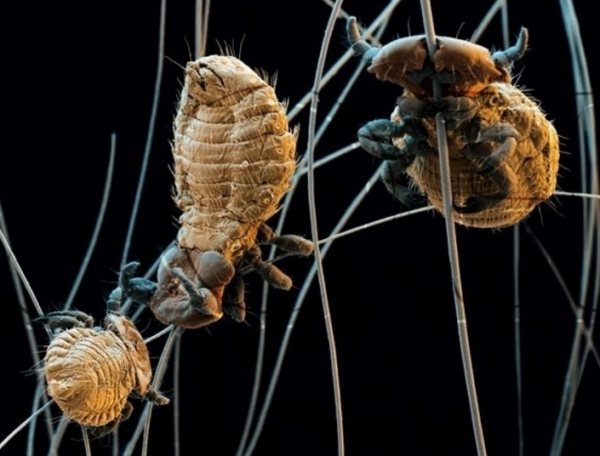

Looking ahead, let's calm down - the problems are being solved. Such tools as Advantiks, Phiprist, Inspector, Advocate are described below. These drugs help to get rid of lice and the consequences of their "diet". The first sign of the appearance of lice is the desire of the dog to scratch itself in the area of the hips, neck and ears.Over time, the whole body begins to itch. The unfortunate animal scratches itself incessantly, and in the places of the most intensive scratching, scratches appear and a crust forms.
In short-haired animals, bald patches appear - in the photo; "sandy" dandruff is noticeable on the hairs. In long-haired mats appear. If the parasites are not dealt with, after a while the hair begins to fall out. In places of bald patches, the skin wrinkles. The dog loses appetite and weight, does not sleep well, drinks a lot.
Ultimately, the animal's immunity decreases, against the background of which it is quite possible to be affected by parasites. The pet may develop problems caused by worms. Some of the helminths are dangerous for humans, so miniature chewing lice cannot be suspected of harmlessness. Therefore, it is imperative to use drops such as Advantix, Fiprist, Inspector, Advocate.
If in doubt that your pet has lice, heat the coat with a lamp. These parasites love warmth, so after a while they will move to the ends of the hairs. Thanks to the photos, you now know what they look like.
Characteristic signs of a louse tick
An animal that is afflicted by a louse becomes very restless. The parasite injects special allergens into the skin, which cause severe itching and discomfort. The dog may refuse to eat and play. The owner can immediately notice the presence of a tick, as the pet's coat becomes tousled, it loses its shine. If you look closely, you can see the parasite, which is easier to do in an animal with dark fur.
The presence of this insect is very dangerous. Over time, the pet may become bald, as the eater mite multiplies at a tremendous rate. You also need to keep in mind that the disease is contagious, and the transition of the parasite from one pet to another will not be difficult. This is important for those who have many animals in their home.
It is not possible to determine the louse at home. These insects are very similar to fleas. It is easy to confuse them and thereby adopt the wrong treatment tactics, as a result of which only the deterioration of the main pathological process will occur. It is important to contact your veterinarian in time for a diagnosis.
This parasite is very insidious, since it is practically invisible to the human eye. It feeds on the blood of an animal and can exist for a sufficient amount of time. Vlase-eater affects the pet's coat and skin. An allergic reaction can be so severe that as a result, the pet will not be able to fully sleep and eat. Depletion occurs in the shortest possible time. The infection is especially dangerous for small puppies, whose immune systems are still too weak.
How to treat a louse in dogs
Choose drugs for lice in dogs after consulting a specialist, carefully and carefully select medications in case of chronic liver and kidney disease, impaired metabolism or advanced age and weakness of the animal. Carefully selected drugs for expensive, purebred dogs, due to their genetic characteristics
The best effect is observed from the use of a whole range of funds, which include:
- insecticidal veterinary medicinal products;
- special medical shampoos for animals, various sprays, ointments, drops;
- protective collars;
- products that are used without direct contact with the animal, serving to get rid of the larvae of insects that carry the infection in the house.
Anti-Whip Shampoo for Dogs
It is advisable to use a special anti-lice shampoo for prophylactic purposes or at the initial stage of infection with this parasite. If the moment of the initial stage is missed and the number of insects is large, then the shampoo will not cope with this problem.This remedy for dog lice is justified by the fact that it is the least toxic of all. In order to completely rid the pet of the problem, the use of shampoo should be repeated, lather very carefully and after 5-10 minutes of treatment, wash off with plenty of water.
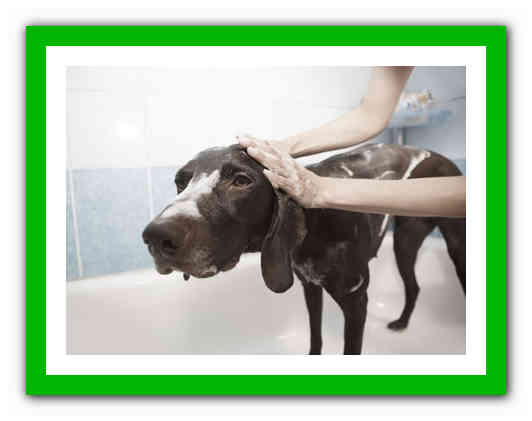

Ointment for dogs from lice
Before you remove the lice from a dog with the help of an ointment, carefully read the instructions so that you know how and in what doses to apply it to the skin of the animal. Veterinarians recommend using "aversectin ointment", which has a wide spectrum of action, including in case of lice infestation, it is low-toxic, effective, does not cause allergies.
In the presence of severely affected areas, they are pre-washed, cleaned, and then carefully applied with ointment. The composition should be applied against the grain, and make sure that the animal does not lick it off, until it is completely absorbed. Use this remedy twice, after the first application, make a scraping, examine for the presence of tick larvae, and, if necessary, repeat the treatment after 5-7 days. Use the ointment in combination with other therapeutic agents.
Drops from lice for dogs
An effective method of treating lice in dogs are drops, which are applied to the withers and spine with the help of a dispenser. One of the drops often purchased in veterinary pharmacies can be considered products, they retain their effect for several days. The negative qualities of the drug can be considered a potent effect, the danger of an overdose of which threatens with allergic reactions and a negative effect on the nervous system. When processing, do not allow the drug to come into contact with the mucous membrane to avoid irritation.
How to deal with insects?
You should not try to treat trichodectosis (a disease provoked by lice) without making sure that the animal is infected with this particular type of lice.
In case of symptoms of the disease, you should contact the veterinarian, who will prescribe a series of examinations to the four-legged patient to make an accurate diagnosis. Only with this approach will the treatment be fast and effective. Using the wrong drugs can cause the disease to become severe, requiring longer and more complex therapy.
Animal handling
To get rid of insects that parasitize pets, you need to use a special tool. It can be spray, drops, insecticidal shampoo. Such drugs act against various ectoparasites and are applied externally. They must be used in strict accordance with the manufacturer's recommendations. If the dosage and duration of treatment are violated, the animal can be harmed. Information about which brands of drugs of different forms of release will help cure a pet of trichodectosis is presented in the table:
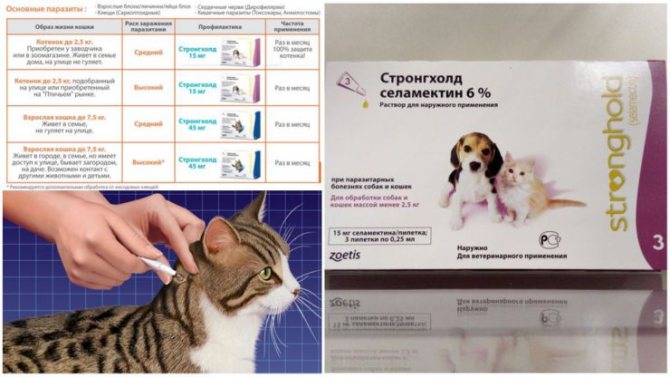

| Drug name | Release form | Active substance | Contraindications for use | The minimum age at which the drug is allowed to be used, weeks | |
| General | Private | ||||
| Stronghold | Drops | Selamectin | Individual intolerance to the components of the drug | Not found | 6 |
| Frontline | Fipronil, permethrin | Severe violations of the liver and kidneys, infections, weakening of the body, weight less than 2 kg | 8 | ||
| Leopard | Fipronil, diflubenzuron, dicarboximide | Infections, convalescence, pregnancy, lactation, body weight less than 2 kg | |||
| Amitan | Amitraz | Rehabilitation period, illness, pregnancy | |||
| Frontline | Spray | Fipronil | Infectious diseases, rehabilitation period, weakening of the body | 2 | |
| Leopard | Infections, recovery from illness, weakening of the body, pregnancy, lactation | 10 | |||
| BlochNet | Fipronil, benzyl benzoate, diethyltoluamide, juvemon | Infections, recovery period, body weight less than 2 kg | 10 - for dogs, 12 - for cats | ||
| Rolf Club 3D | Fipronil, etofenprox, pyriproxyfen | Infectious diseases, weakening of the body, pregnancy, lactation period, weight up to 500 g | 12 | ||
| Insectal | Fipronil, pyriproxyfen | Infections, recovery period after illness | |||
| Celandine | Permethrin | Infectious diseases, rehabilitation period | The drug has no age restrictions | ||
| Phytoelite | Shampoo | Permethrin | Infections, rehabilitation and breastfeeding period | 8 | |
| Demos suite | 12 | ||||
| Lugovoi | Infectious diseases, convalescence, pregnancy, lactation | ||||
| Leopard | Essential oils of lavender and costus, extracts of cloves and geraniums | Not found | The shampoo has no age restrictions | ||
You can try to rid your pet of these parasites using a collar. This device is a length-adjustable rubber or PVC tape impregnated with a poisonous substance. Such devices have a long life span. Usually it is 3 to 8 months. Among the most popular brands of collars are Bars, Beafar and Foresto.
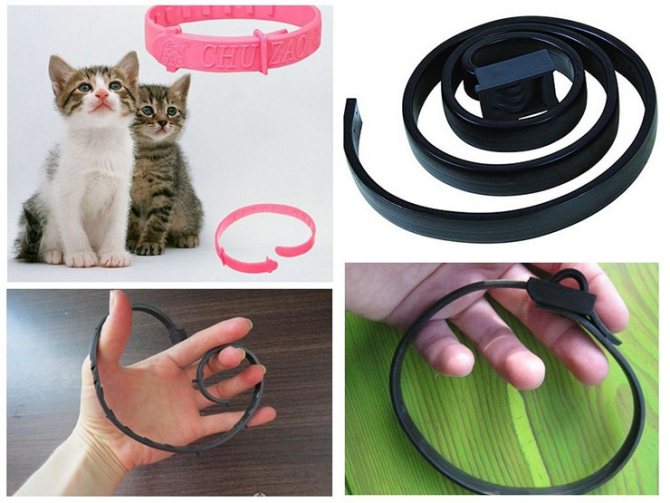

If you can freely insert 2 fingers under this device, then its length is adjusted correctly. If the skin under the collar of the pet has irritation and hair begins to fall out, it must be removed immediately. Such symptoms indicate an allergic reaction to the substances with which this device is impregnated.
To remove a cat or dog wool beetle by means of folk remedies that you can prepare yourself at home. They are usually used to treat kittens and puppies whose skin is too delicate; harsh chemicals can harm them. Dust and chloramine should not be used to get rid of wool beetles. If these agents enter the open wounds, the animal will experience unbearable pain. The table provides information about the most effective folk remedies against lice:
| Ingredients | Preparation | Application |
| Sagebrush | Pour 200 g of dry or 500-600 g of freshly picked herbs with 4 liters of hot water. Simmer the mixture over low heat for 15 minutes or infuse in a water bath for 30 minutes. After cooling completely, strain the broth. | Bathe your pet in the product 2-3 times a week until it is completely cured. |
| Chamomile | ||
| Ramson | ||
| Succession | ||
| Garlic | Pour 200 ml of water into 1 tbsp. l. chopped garlic. Strain the liquid infused for 2 weeks. | Treat the skin of the animal with a cotton pad dipped in the product. |
Treatment of litter, places where the pet is
To get rid of the lice, it is not enough to process the pet. Wool beetles can hide in a couch or other places in the house for the duration of the drug's effect. To prevent the parasites from returning to the owner, it is necessary to carry out a thorough disinsection of the room in which the animal who has recovered from trichodectosis lives.
Pest control can be carried out in several ways:
- Wash your four-legged friend's bedding and toys in hot water. It is better to use an insecticidal shampoo for washing. In winter, you can take your dog's or cat's personal items out into the cold for several hours.
- Wash the floor and wipe other horizontal surfaces in the room where a cat or dog who has been ill is present with an insecticidal agent (Karbofos, Reid, Phenaxin). You can use folk remedies that were used for bathing your pet for wet cleaning.
Symptoms and signs of the disease
After a pet is infected with trichodectosis, quite characteristic symptoms and signs appear, which an attentive owner will immediately pay attention to. ... The dog becomes restless, constantly itching and gnawing at itchy places. The animal's appetite decreases. The appearance of the coat changes
It becomes sparse, dull, dirty, covered with dandruff, parasite excrement, their eggs, larvae and sexually mature individuals. Signs of the waste products of ectoparasites may appear.
- The dog becomes restless, constantly itching and gnawing at itchy places.
- The animal's appetite decreases.
- The appearance of the coat changes. It becomes rare, dull, dirty, covered with dandruff, parasite excrement, their eggs, larvae and sexually mature individuals.
- Signs of the waste products of ectoparasites may appear.
Signs of infection
Symptoms of lice in dogs are as follows:
- constant itching, which leads to the appearance of wounds;
- the presence in the dog's coat of small white grains resembling dandruff (only upon close examination can you notice their movement);
- the pet's hair loses its healthy appearance - it fades, sticks together into lumps, it is even possible to remove hair with a louse;
- the inner thighs, the base of the tail and the head of the dog are especially prone to baldness. Such areas become swollen and reddened, and may become crusty;
- lack of appetite and feeling thirsty leads to weight loss;
- restless behavior of the dog, itching becomes the cause of its insomnia.
What do lice look like
In order to take measures in time and prevent the development of the disease, you need to know what the lice look like and what are the features of their life cycle.
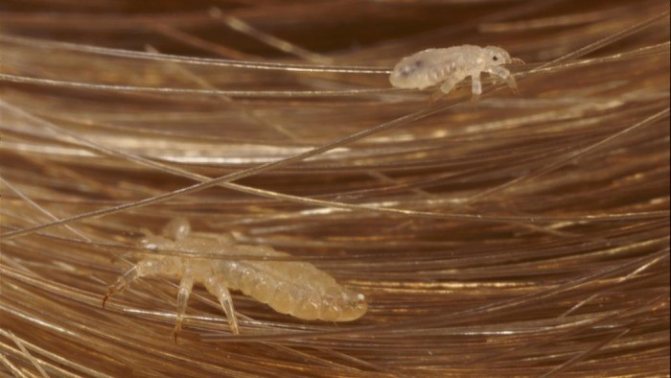

The presented insects, the sizes of which are from 1.4 to 2.2 mm, have an elongated flattened body of light yellow color. The quadrangular flat head is wider than the thoracic region, to which 3 pairs of limbs are attached, ending in claws. The whitish abdomen is divided into 9 segments.
The parasites feed on the oral apparatus, which consists of powerful jaws. By capturing the hair with their teeth, they first firmly attach to it, and then gnaw and chew.
Unlike fleas, the entire developmental cycle of lice takes place on the dog's body. Females lay white oval eggs on the root part of the hair, firmly gluing them with uterine secretion.
After 6-10 days, larvae emerge from the eggs, similar to adults, but smaller in size. In 2-3 weeks after three molts, they turn into full-fledged sexually mature parasites capable of fertilization and reproduction. However, once in the external environment, they die within eight days, even at optimal temperatures and humidity.
Food for lice is wool, fluff, particles of keratinized epithelium, the secretion of the sebaceous glands.
Important! Through damaged skin at the sites of scratching, parasites can feed on blood and lymph, increasing itching and inflammation. ...
Vlaseoids
This insect is very small, up to 2 mm in length, the body is flat, the head is quadrangular. It propagates with the help of nits, which in appearance resemble dandruff, but it is not removed. In 14 days, the first larvae appear, and then they turn into adults.
The lice feed on blood, secretions of the sebaceous glands, epidermal cells. As a result, a disease develops - trichodectosis.
Are lice dangerous for humans
They are afraid that lice in dogs are transmitted to humans, it is not worth it, parasites live and multiply on the skin and hair of animals. Worm beetles are thermophilic insects, the absence of hair in humans and a lower body temperature than in dogs, does not give the parasites the opportunity to live and reproduce. A real danger for humans can be the consequences of an accidental bite, since the insect can be infected.
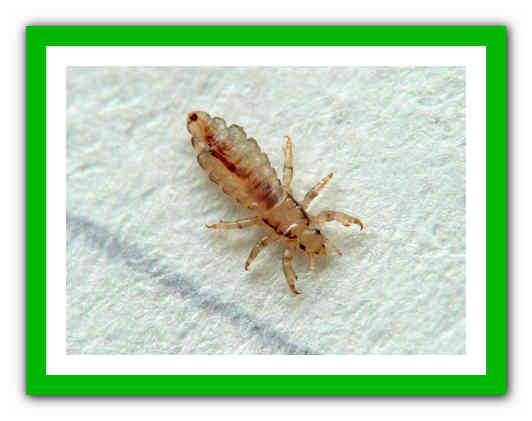

To prevent the occurrence of lice in a dog, you need to limit its communication with animals, the state of health of which you do not know. It is better if the pet will communicate with fellows, the owners of which you know and are sure that they are conscientiously and carefully looking after their pets. It is easier to prevent a tick than to treat it later.
Vlasoids in dogs.
Vlase-eaters in dogs are a very urgent problem that many owners of four-legged friends face. Given the rapid development and reproduction of parasites, it becomes doubly serious.After all, the presence of pests in the animal's fur gives it great discomfort, the consequence of which can be significant health problems for the pet. Having found wounds on the pet's body, which are a consequence of the habitat of lice, it becomes clear the need to take urgent measures to combat the pest.
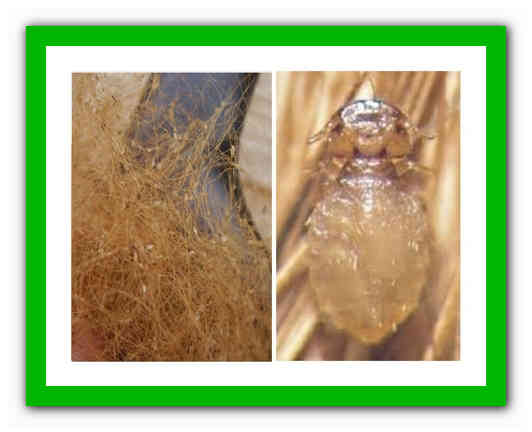

In nature, there are about 100 species of various parasites that live in animal fur. Only dogs are infected with canine lice. This can happen while walking or in contact with a relative. A person is also capable of infecting a pet by bringing the pest into the house on his clothes or shoes. Even lice can be found in a puppy, which were passed on from the mother.
Due to the fact that the ways of infection with lice are quite diverse, only regular examination of the pet can prevent such a problem. If this moment is missed, the healing process will be more protracted, since it is difficult to cure the disease with an excessive accumulation of insects.
Infection
The parasites are easily transmitted and quickly adapt in the "fur coat" of the new host. It is noted that in spring and autumn it is more likely to pick up a pest than in other seasons.
Ways of infection with lice are different. There are several ways to catch the infection:
- From sick rats or mice if present in the dog's habitat. When moving from rodents, larvae or adult representatives fall, which subsequently move to other owners of wool.
- With direct contact. It is possible to catch parasites on a walking area, training sessions, or simply when colliding with sick animals. Large-scale infection of dogs is possible in nurseries, shelters, where many individuals live on the same territory.
- From mother to offspring. If the bitch did not have time to be cured before giving birth, then when the litter appears, the lice are transmitted to the puppies.
- Application of general care items. Parasites are spread through combs, brushes, scissors, clippers, leashes, towels. Therefore, it is recommended to use only personal items. Such a measure will protect against fleas and lice, as well as various infectious diseases.
- Through clothing or shoes. The breeder can bring the louse or his eggs from the street. The pest enters the house on the soles of boots or outer clothing.
The increased importance in the territory where the dog lives, rare bathing, lack of grooming, poor nutrition contribute to the activation of the life of the louse and the rapid spread. The worse the animal is kept, the more aggressively insects attack.
Sources of infection
The main group at risk of invasion are dogs in contact with stray animals. Although the eater tick is also found in domestic dogs, whose owners neglect preventive treatments for their pets.
The next on the list of candidates for defeat by lice are pets that have visited shelters and zoological hotels. The mass accumulation of animals in one place increases the risk of infection with trichodectosis several times. If the owners of the above mentioned establishments regularly process the premises and equipment with disinfectants, this will not happen.
The parasite can enter the pet's coat through the owner. Larvae, like sexually mature parasites, are easily carried by humans on hands, clothes, and shoe soles. They are transmitted to the dog without harming humans.
Attention! This type of ectoparasite is not dangerous to humans, lice prefer a higher body temperature than humans. ... Infection with a louse tick in dogs that have visited the grooming salon is not excluded.
The lice beetles are transmitted through non-disinfected equipment (combs, brushes, scissors). Also through the ammunition (collars, harnesses, muzzles).
It is not excluded that a mite is infected with a louse in dogs that have visited the grooming salon. The lice beetles are transmitted through non-disinfected equipment (combs, brushes, scissors).Also through the ammunition (collars, harnesses, muzzles).
Ectoparasites are passed on to newborn puppies from the mother. They disrupt the microflora, slow down growth, and provoke hysteresis in the development of the baby.
The clinical picture of infection
What are the symptoms of infection? The main sign of the presence of ectoparasites is severe itching when the animal constantly scratches itself and even bites. Of course, with minimal care, you can also notice the "heroes of the occasion" themselves, briskly moving in the coat.
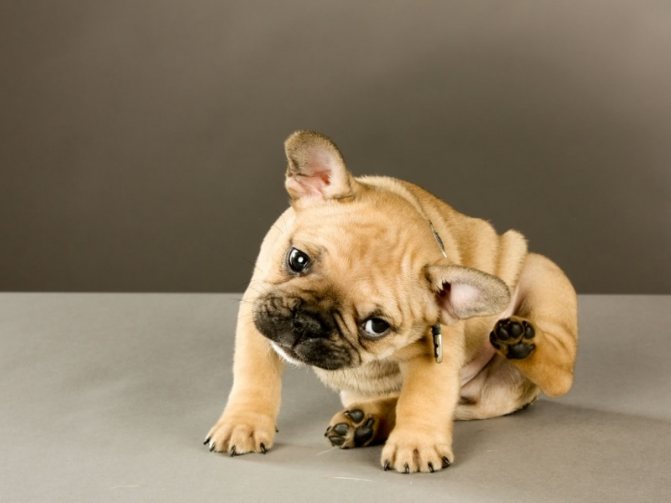

Lice nits are clearly visible even to the naked eye. You can also arm yourself with a fine comb and "walk" through the most suspicious places. If an animal has parasites, you probably won't be left without a catch. The consequences of constant bites are most clearly visible on young kittens and puppies.
Babies suffering from constant bites and severe itching lose their appetite, become lethargic, and itch constantly and with fierceness. All this quickly leads to exhaustion. The skin in the places of the bites becomes inflamed, begins to peel off. If there are a lot of parasites, and your pet's body is predisposed to the development of allergic reactions, flea dermatitis may occur.
Can dog and feline bloodsuckers pose a danger to humans? If your pet has caught lice or fleas, don't panic! Parasites are very "finicky" and species-specific. They do not like to "quarter" on a person. The maximum that you can face is occasional cases of bites, accompanied by mild itching.
Preventive measures
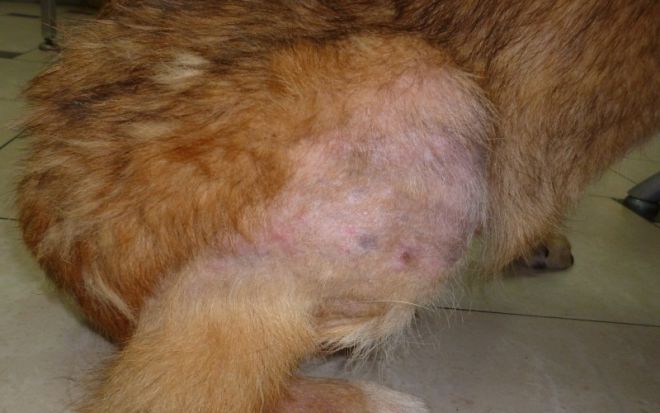

It is better to prevent the onset of the disease than to carry out treatment, therefore, below we list the preventive measures that will help to avoid infection:
- Regular replacement and disinfection of the dog's bedding. If the dog lives in a booth on a permanent basis, then it is regularly necessary to treat it with solutions that destroy parasites.
- Preventive bathing of the animal using targeted shampoos.
- Limiting contact with stray dogs and cats.
- Use of special collars.
- Regular skin examinations at home, as well as by a veterinarian.
To protect the dog from various diseases, and even more so from annoying lice, it is necessary to constantly observe preventive measures. Prevention consists in regular cleaning of the animal's room, shaking, washing and cleaning the bedding, wet cleaning in the apartment, and disinfection.
All these actions will reduce the risk of infection with lice. It is best to keep the dog away from family members and other pets during treatment.
From time to time, the dog needs to be taken to the veterinarian for examination. The lice and their eggs found in time are easier to destroy and process. Do not allow neglect when the process of baldness begins.
Vlasoids in dogs symptoms of infection
Vlasoids carry different types of diseases and infections. They move along the body of the animal, bite it, which causes constant itching. This is the main symptom of the presence of a louse.
The dog is constantly itching, its attention and concentration decreases, it does not obey the owner, the character changes for the worse. From the fact that the animal is constantly itching, it develops wounds that develop into dermatitis
All this leads to baldness of the skin area.
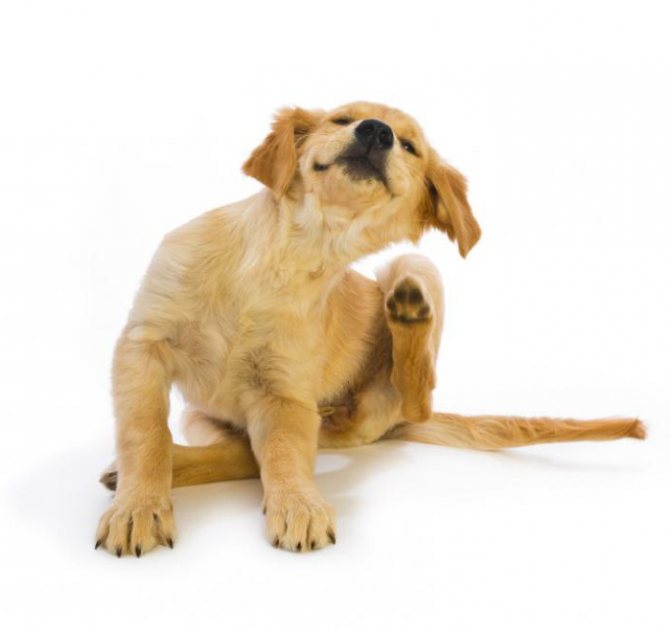

Seeing that your animal is constantly busy sitting and itching, you need to immediately examine the fur and skin. Dog lice are different from fleas: fleas have a smaller head, and the louse has a smaller head. If you do not immediately start treating the dog, then it will begin to lose weight, weaken, and other diseases may appear. In addition, various infections can enter the animal's body through wounds on the skin. Also, lice in dogs easily transfer eggs as they are their intermediate owner.
So, we list all the symptoms of a louse infection:
- constant itching (lasts for several days);
- When inspecting the coat, you can see white skin segments that look like dandruff;
- the coat looks dull and as if sheared;
- the hair on the face or in the tail area falls out;
- in the place where the coat is peeled off, the skin is swollen and looks inflamed, sometimes covered with a crust;
- the animal loses much weight;
- the dog is very restless;
- the attention of the animal is absent;
- the dog becomes naughty and nervous.
Danger of infection
Trichodectosis causes itchy skin in a dog. The animal is constantly itching, violating the integrity of the epidermis. As a result, there is a risk of infection with dermatitis or eczema. In places where parasites accumulate, hair falls out, and allergic reactions can occur.
Immunity decreases, which makes the animal practically defenseless against viral infections. Chronic and latent diseases are aggravated. The constant itching of the skin prevents the pet from sleeping, as a result of which the mental state of the animal is disturbed.
Among other things, blood-sucking insects can be carriers of helminths. Infection with worms will lead to intoxication, anemia, and intestinal dysfunction. Do not avoid swings in appetite, indigestion.
Preventive actions
It is better to prevent the onset of the disease than to carry out treatment, therefore, below we list the preventive measures that will help to avoid infection:
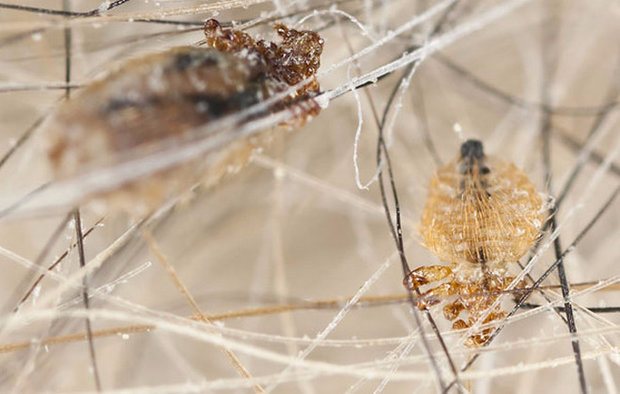

- Regular replacement and disinfection of the dog's bedding. If the dog lives in a booth on a permanent basis, then regularly you need to treat it with solutions that destroy parasites.
- Preventive bathing of the animal using targeted shampoos.
- Limiting contact with stray dogs and cats.
- Use of special collars.
- Regular skin examinations at home, as well as by a veterinarian.

